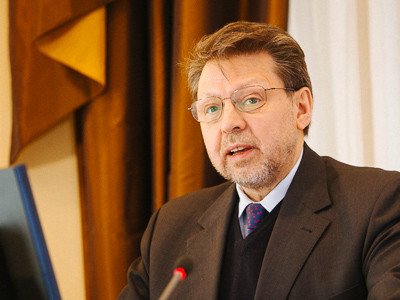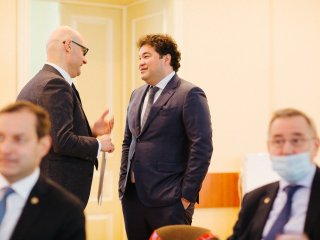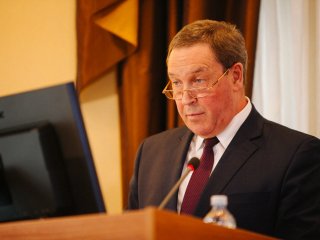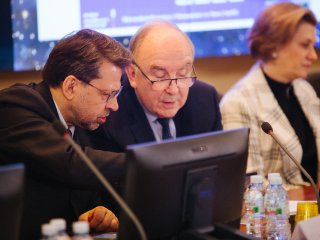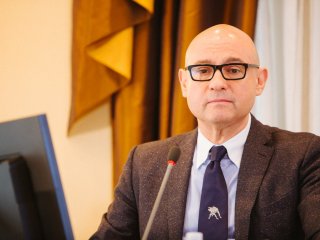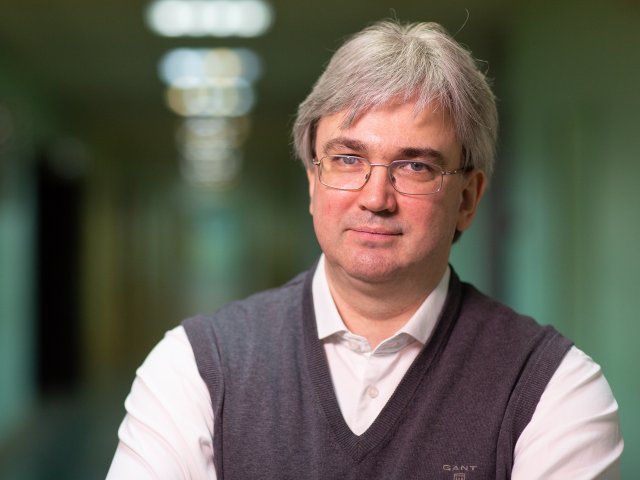On April 19, 2021, the Department of Medical Sciences of the Russian Academy of Sciences holds its general meeting. Key topic: “The 60th anniversary of Yu.A. Gagarin's spaceflight and current health problems.” The meeting is hosted by RAS Academician Vladimir Ivanovich Starodubov.
Presentation highlights:
- “Space Medicine: Our Achievements and Future Challenges.” RAS Corresponding Member Oleg Yuryevich Atkov.
- “Epidemiology of COVID-19. Diagnosing the SARS-CoV-2 virus and monitoring its evolution.” Head of Rospotrebnadzor (Russia consumer and sanitary welfare oversight authority), surgeon general of the Russian Federation Anna Yuryevna Popova.
- “Genomic epidemiology of the novel coronavirus infection: from monitoring of the variability of SARS-CoV-2 to the creation of personalized predictive models.” RAS Corresponding Member Veronika Igorevna Skvortsova; Doctor of Medical Sciences, Professor Sergey Mikhailovich Yudin.
Scientific outcome of the pandemic.
- “Results of the work of the consortium of the academic community on studying COVID-19.” RAS Academicians Vadim Markovich Govorun, Dmitry Yuryevich Pushkar.
- “How did our approaches to the treatment of COVID-19 patients evolve.” RAS Corresponding Member Sergey Nikolayevich Avdeyev.
- “Modern industrial biotechnology: development and production of next-generation whole-virion vaccines.” RAS Corresponding Member Aydar Ayratovich Ishmukhametov.
- “A multidisciplinary approach to intensive care for patients with the novel coronavirus infection. Experience of the N. V. Sklifosovsky Research Institute of Emergency Medicine. RAS Corresponding Member Sergey Sergeevich Petrikov.
- “On the results of the work of the RAS Department of Medical Sciences in 2020 and tasks arising from the program of fundamental scientific research in the Russian Federation (2021-2030).” Academician Vladimir Ivanovich Starodubov.
And others.
The Scientific Russia portal is hosting a live broadcast of the general meeting of the Department of Medical Sciences of the Russian Academy of Sciences. Be sure to join us!
10:05. Participants are welcomed by RAS Academician Vladimir Starodubov. Members of the department honor the memory of their late colleagues.
10:08. Vice President of RAS Vladimir Chekhonin talks about results of the work of the Department.
10:13. “Let me remind you that this is the second national program in which the Department of Medical Sciences of the Russian Academy of Sciences takes an active part.”
10:15. “Given the complicated global political situation, the Presidium of the Russian Academy of Sciences, as well as the Department of Medical Sciences have taken measures to ensure that Russian scientists do not remain isolated,” says the Vice President of the Russian Academy of Sciences. Vladimir Chekhonin noted that the department has become the organizer of key scientific international events: conferences and symposia.
10:18. The scientific and medical communities pay great attention to neurodegenerative diseases.
10:21. Vladimir Starodubov presents prizes to members of the Department.
10:23. RAS Corresponding Member Oleg Yuryevich Atkov speaks. His presentation focuses on space medicine.
10:24. Oleg Yuryevich recalls scientists who pioneered the development of manned spaceflight in Russia having made their great contribution.
10:25. “Major factors of orbital spaceflight adversely affecting the human body include zero gravity, overload, exposure to radiation, psychoemotional stress, temperature fluctuations, isolation, limited mobility, and others.”
10:28. “Zero gravity plays a special role it the genesis of adaptational shifts as it impacts the redistribution of liquid media in the body.”
10:31. Main changes in the body during long spaceflight missions include hypohydration, negative ion balance, change in secretion of a number of hormones, reduced red blood cell count and others.
10:33. Suppression of cell-mediated immunity is also observed.
10:35. “A cosmonaut’s spine gains 4 cm in length,” notes Atkov.
10:36. Oleg Yuryevich talks about devices allowing to study bodily functions under the influence of spaceflight conditions. Thanks to some of them, our country has become a pioneer of space medicine.
10:40. Atkov speaks of prominent medical cases in spaceflight.
10:44. According to American colleagues, cases of acute appendicitis can occur once every 5-6 years.
10:45. Telemedicine is actively used within the framework of space medicine.
10:47. Space weather factors include radiation – the effect of heavy charged particles, high-energy solar proton events.
10:50. Problems of crew heterogeneity are associated with cultural and linguistic differences that have a significant impact on crew communication.
From a presentation by O. Yu. Atkov
10:58. Head of Rospotrebnadzor, surgeon general of the Russian Federation Anna Yuryevna Popova speaks.
10:59. Russia ranks 87th by daily morbidity. “The situation is becoming more stable,” Popova notes.
11:01. “Sanitary and quarantine controls are the first barrier to infection in the country.”
11:02. Наращивание объемов диагностических мероприятий позволяет быстро выявлять инфицированных. На сегодняшний день диагностику осуществляет более 1000 лабораторий.Ramping up diagnostic measures enables rapid identification of infected people. To date, diagnostics are carried out by more than 1000 laboratories.
11:04. The head of Rospotrebnadzor noted that the virus can become seasonal in the future.
11:07. An important aspect was the study of the etiology of community-acquired pneumonias in pandemic conditions.
11:09. “More than 5740 biological samples have been obtained from all regions of Russia, 942 isolates of the new coronavirus have been sampled,” says Popova.
11:12. Anna Yuryevna talks about scientific programs carried out by Rospotrebnadzor.
11:15. A web platform was developed and launched for downloading and analyzing data, as well as displaying the results of virus sequencing.
11:18. “A methodology was developed and an effective serological monitoring system was deployed to assess the level of herd immunity in different regions of the country in order to predict the epidemiological situation, make recommendations and plan vaccination.”
From a presentation by A.Yu. Popova
11:25. Access to vaccination is a priority today.
11:28. “Today, only 20 Russia’s constituent subjects (out of 85 – transl.) have lifted restrictions for persons older than 65.”
11:30. Anna Popova talks about a twofold gap in epidemiological readings between regions on the one hand and large cities and capitals on the other hand.
11:32. A presentation, Genomic Epidemiology of the Novel Coronavirus Infection: from Monitoring of the Variability of SARS-CoV-2 to the Creation of Personalized Predictive Models, by RAS member, Professor Sergey Mikhailovich Yudin.
11:38. In 2020, more than 27,000 single nucleotide mutations (point mutations) in the virus genome were detected globally. A study conducted in 2020 by the Federal Medical and Biological Agency of Russia identified more than 3,500-point mutations in the genome, including the S protein of the virus.
11:43. A calculator of severe COVID-19 cases has been created.
11:50. Denis Yuryevich Logunov speaks.
11:52. Gamaleya Center has gained experience, inter alia, with the development of vaccines based on DNA, recombinant viral vectors, subunit and virus-like particles.
11:57. Denis Logunov talks about vaccines developed in the center.
12:00. Thanks to the experience gained earlier, the Gamaleya Center was able to develop the Sputnik V vaccine in the shortest time possible.
12:05. НAt the time of the interim analysis, 70 cases of serious adverse effects (SAEs) were reported in 68 volunteers: 45 volunteers from the vaccinated group and 23 volunteers from the placebo group. None of those SAEs were vaccination-related.
From a presentation by D. Yu. Logunov
12:10. Questions come from the audience following the presentation.
12:19. Academician Dmitry Yuryevich Pushkar speaks. His report focuses on a consortium of the academic community for COVID-19 research.
12:23. Studies focused on several directions. An atlas of infection-induced pathologies was created.
12:28. Co-presenter Vadim Markovich Govorun continues his presentation and points to the life cycle of the virus and its pathways for entering the cell.
12:33. IgG antibodies found in patient serum were discovered to target not only structural but also non-structural proteins of coronavirus.
12:36. “Patients with severe form have different diseases, and the mechanisms of their development are not fully known,” says the speaker.
12:41. Questions from participants of the general meeting of the Department of Medical Sciences are sounded.
12:52. RAS Corresponding Member Sergey Nikolayevich Avdeyev speaks. His presentation focuses on approaches to the treatment of COVID-19.
12:54. “Mortality is quite high, and the disease has an unpredictable course,” says the scientist.
13:00. Avdeyev points to recent research that has contributed greatly to the development of coronavirus disease diagnostics.
13:08. Members of the Department ask their questions.
13:13. A break is announced. Participants will resume their work at 13:30. Stay tuned.
13:36. RAS Corresponding Member Sergey Vladimirovich Borisevich speaks.
13:40. Studies were carried out inter alia on particular aspects of infection in laboratory animals and companion animals infected experimentally: domestic cats and dogs.
13:45. “In terms of virus-neutralizing activity, a positive response is observed in 90.4% of subjects immunized with both components of the Sputnik V vaccine, and the level of positive antibodies in ELISA assays read 93.5%,” says Borisevich.
13:50. Experts from the 48th Central Research Institute facilitated preclinical and clinical appraisal of immunobiological drugs developed by Russian research organizations.
13:55. Participants are discussing the Sergey Borisevich’s presentation.
13:57. The report of RAS Corresponding Member Aydar Ayratovich Ishmukhametov focuses on modern industrial biotechnology and the development and production of next-generation whole-virion vaccines.
14:00. “All preparations to date, including those on the national vaccination calendar, are based on whole-virion vaccines. However, one should not be deceived thinking that this is the same model. The model has evolved.”
14:05. State-of-the-art industrial technologies ensure maximum predictability of results, manageable and scalable processes, high-quality vaccines, speedy development and launch into production, as well as economic efficiency.
14:08. Major stages of vaccine creation include selecting an industrial strain, selecting a cell culture, determining inactivation and purification conditions to achieve safety and immunogenicity, applying quality control and vaccine safety techniques.
14:11. “We are used to the fact that the virus is a potentially dangerous entity. This fact is often invoked as an argument to discredit whole-virion vaccines.”
14:15. Questions are taken from the participants.
14:22. RAS Corresponding Member Sergey Sergeevich Petrikov speaks.
14:24. Experience has shown that a COVID-19 ward requires 30% more staff than usual care departments. Intensivists make up the most of this staff.
14:27. “When a COVID-19 ward is situated within a multidisciplinary emergency hospital, it becomes possible to provide all kinds of care to coronavirus patients with no delay. Logistics are streamlined in cases when coronavirus-infected patients are found in mainstream ‘clean’ wards.”
14:30. “COVID-19 provided a certain impetus to the development of extracorporeal membrane oxygenation.”
14:34. Hemodialysis methods should be used if acute renal failure develops under an extended treatment regimen. It is advisable to use cytokine elimination methods to counter cytokine storm.”
14:37. Helium-oxygen mixture, which has traditionally been used in lung transplantation, has proven effective in the treatment of COVID-19-induced pulmonary pathologies.
14:40. Questions come from the audience following the presentation.
14:47. RAS Academician Gennady Grigorievich Onishchenko takes the rostrum.
14:50. Gennady Onishchenko revisits the issue of vaccine types and foreign experience.
14:55. “A question of special joint session of the Academy of Sciences with other departments should be raised before the Bureau of the Russian Academy of Sciences. This way the range of problems to be addressed by the department can be outlined.”
15:03. Vladimir Starodubov sums up the general meeting of the department.
15:05. Vladimir Chekhonin: “All speakers’ presentations are proof that RAS continues to play an important role in the field of creating diagnostic systems and medicines.”
15.14. Vladimir Ivanovich Starodubov delivers his report on the results of department’s activities.
15:28. The general meeting of the Department of Medical Sciences is over. Thank you for joining us!
